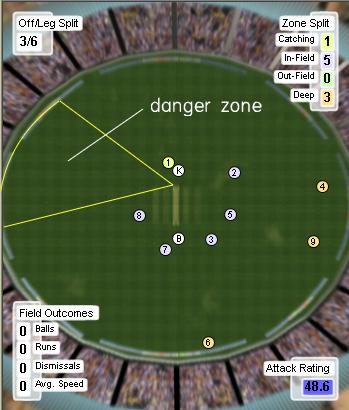Andrew Flintoff was on the rampage.
The 6ft 4 all-rounder had been served up some easy half volleys in his innings in the third Ashes Test and was walking with a confident swagger.
Given that England were looking to move the game on, it was certain Flintoff was going to go after the spinner. So it proved with Hauritz being deposited for a six over long on and a swept four in the same over.
It's not just Test spinners that are attacked though. Spinners of all ages and skill levels experience the same problem. So how do you deal with the batsman whose eyes light up as soon as the spinner comes on?
1. Stay confident
Spin is a mental battle as much as a physical one: The spinner is trying to tease a mistake and the batsman who is playing a few shots is more likely to make one. That's why you have to stay confident in the face of an assault.
This is easier said than done. The captain suddenly can't look at you, the batsman has biffed your best ball to the boundary and you don't know what to do next.
The secret is to clear your mind, set a plan in your head and bowl that ball. A classic cliche in cricket is to play the ball not the man. This is just as true for the spinner under the pump. Keep bowling to your plan and you can force an error.
2. Cut off the big shots
Speaking of a plan. What is it?
All players, even at Test level, have their favourite and less favourite shots. Club and school players are even more limited than the professionals. This means the first job is to cut off the big shots, especially if they are with the spin.
For example, if you are an off-spinner bowling to a right handed batsman who plays with a lot of bottom hand you might put boundary fielders out at long on, deep midwicket and deep square leg. This suddenly makes it a lot riskier to play the big shot through the leg side.
In this example, you can accentuate the point by bowling around the wicket, pitching on off and turning to hit the stumps. The arm ball will slide across a batsman making it possible for it to be sliced straight up.
Your foe may still go for it, and with a big enough hit may even succeed, but suddenly they are the one taking the risk. If you get hit for a six and a four and then get a catch on the boundary your average is 10 and you are having a good day!
For leg spin and left arm spin against right handers the big shot with is more likely to be with the spin through the off side.
3. Keep the weaker areas open
The other side of blocking off a batsman is tempting him or her with a gap in the field. Let's imagine our off-spinner again bowling to this field:

As you can see from the yellow "danger zone" area, there is a large gap between slip and extra cover. Remember the batsmen plays with a lot of bottom hand? They will see the gap and look to play the ball into it for boundaries.
As long as you bowl well (pitched up, round the wicket, turning a little) it's very difficult to hit the ball into that area and the chances of bowled, LBW, caught at slip and even caught on the leg side are massively increased.
The left arm spinner can use a similar plan, keeping mid on up and inviting the on drive over the top. Not many batsmen can play this shot well, especially against the ball turning away and can slice it to the off side or bring the bottom hand in and hit it to deep midwicket.
4. Use variety
The final element is what type of ball you bowl. Each batsman has a different pace and flight that they are least comfortable against. So like it thrown up but hate it fired in. Some are the opposite. Even when you are under pressure you can experiment with how much spin, pace and flight you give the ball.
Tossing one up might seem like the last thing to do when you are being hit. Most bowlers tend to bowl flatter and more at the stumps in this situation. However, if you have confidence in your plan (which is the first three steps) you can risk trying something different.
All batsmen are better when they know the pace of the ball. Adding a little or taking some off in the flight it a great way to disrupt their rhythm, especially if they have their best shots cut off and are trying to do something unfamiliar.
The captain isn't going to take you off in the middle of an over so you have at least 6 balls to tease even the biggest hitter out.
Let's be honest, the chances of bowling to a player of Flintoff's ability are low, so exploit your awareness of a batsman's weaknesses and you will get more in the wickets column, even against attacking players.
image credit: zoonabar
Field setting image supplied by PitchVision - Coach Edition. Available to purchase now for clubs, schools and cricket centres.
Discuss this article with other subscribers
|

.jpg)




.jpg)


